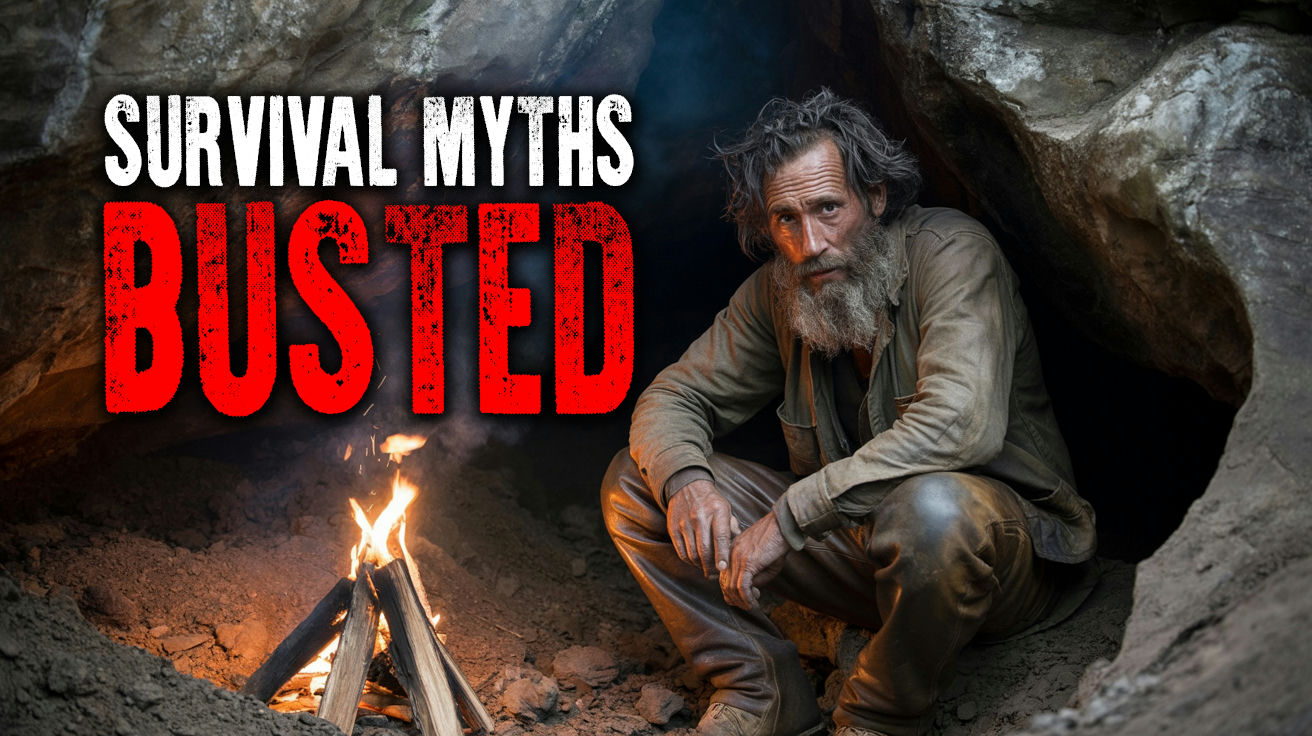Forget Instagram filters and reality shows—outdoors, bad information kills faster than predators. Those survival “tips” from movies? About as useful as wet matches. According to National Park Service data, backcountry accidents increased 23% since 2015, making accurate knowledge crucial for staying alive.
Think of common survival myths as that friend who always gets lost despite swearing they know a shortcut. Research from The Wilderness Medical Society shows these myths don’t just confuse—they actively endanger lives. The gap between movie heroics and backcountry reality isn’t just wide; it’s dangerous territory few return from.
20. Snakebite Salvation or Suicide?

That dramatic scene where someone sucks venom from a snakebite? Pure fiction that endangers lives. Venom travels through tissue rapidly, making suction attempts futile—comparable to stopping a flood with a paper cup.
The effective response involves keeping still, removing constrictive items from the affected limb, and seeking medical help within six hours. Dr. Robert Norris at Stanford University Emergency Medicine confirms that victims attempting venom extraction typically suffer worse outcomes. Your mouth bacteria entering an open wound creates an additional infection risk, complicating treatment.
19. Bee Escape Plans That Actually Work

Diving underwater to escape bees makes about as much sense as using a sieve as an umbrella. These determined insects will hover patiently, waiting for your inevitable gasp for air—they’re essentially nature’s most persistent trackers.
The American Beekeeping Federation recommends running in a straight line for at least a quarter-mile, preferably through dense brush that disrupts their flight path. Bees track you through pheromones, so changing direction doesn’t help. Sometimes the simplest approach (just keep running) outperforms any dramatic movie moment every time.
18. Frostbite: The Rub That Ruins

Rubbing frostbitten skin feels intuitive but causes severe damage. According to the Journal of Wilderness Medicine, frostbitten tissue contains ice crystals that, when rubbed, damage cell structures beyond repair.
Emergency medicine physicians recommend gradual rewarming in 104-108°F water—similar to a warm bath. University of Colorado wilderness medicine data shows amputation rates nearly double with improper first aid. Remember this rule: if there’s any chance of refreezing, postpone treatment. The freeze-thaw-refreeze cycle creates irreversible tissue damage worse than the initial frostbite.
17. Desert Mirage: The Cactus Cocktail

The image of a thirsty hiker slicing open a cactus for a refreshing drink belongs in fantasy, not reality. According to desert ecology research from the University of Arizona, most cacti contain harmful compounds that cause severe dehydration.
While the barrel cactus and prickly pear can provide emergency moisture, they require specific preparation. Desert survival educator Thomas Coyne notes that hospitalization cases outnumber successful hydration stories when people attempt drinking from random cacti. The fluid typically causes vomiting and diarrhea—worsening your water deficit rather than helping.
16. Survival Priorities: What Actually Kills

Ask novice outdoor enthusiasts about survival priorities, and finding food typically tops their list—similar to reorganizing furniture while your house burns. The human body functions like a resource management system where temperature regulation matters most.
The National Outdoor Leadership School reports that 72% of wilderness fatalities result from exposure, not starvation. Remember the Rule of Threes: three hours without shelter in harsh conditions, three days without water, three weeks without food. Renowned survival instructor Cody Lundin compares hunting while dehydrated to buying decorations for a burning house—a deadly misalignment of priorities.
15. Shelter First, Fire Second

The impulse to build a fire first feels natural. Yet this instinct, reinforced by adventure films, ignores a fundamental truth documented by search and rescue teams: exposure kills faster than low body temperature alone.
Wind and rain drain body heat regardless of how much warmth you generate—similar to heating a room with all windows open. A basic lean-to shelter, even from garbage bags and branches, creates a microclimate preserving body heat. The International Journal of Wilderness Medicine found that survivors who prioritized shelter over fire had a 32% higher survival rate in adverse weather conditions. The most effective survival strategies center on methodical, proven basics—not flashy improvisation. To further boost your chances in the wild, check out these essential survival gadgets that can make a life-saving difference.
14. Fire Inside a Cave: The Silent Killer

The image of a cozy cave fire seems appealing but creates deadly risks. Without proper ventilation, caves become carbon monoxide traps that can be fatal within hours, according to the American Cave Conservation Association.
Search and rescue records show numerous cases where victims succumbed to smoke inhalation rather than exposure or injury. Caves present another hazard: when rocks heat unevenly, they can fracture and fall without warning. Building your fire near the entrance or using emergency blankets instead could save your life when shelter options are limited.
13. Quicksand Reality Check

Movie quicksand scenes suggest a bottomless pit waiting to swallow victims whole—as realistic as sharknados. Geological studies show that human bodies are less dense than quicksand, making full submersion nearly impossible without added weight.
Geology professor Daniel Bonn explains that quicksand is simply saturated sand creating a non-Newtonian fluid that behaves uniquely under pressure. Distributing your weight by leaning back and making slow movements gradually frees you. Panic-induced thrashing creates suction that pulls you deeper—a physical reaction that works against escape.
12. Animal Diet Disasters

Watching animals eat plants doesn’t mean you’ve found safe food. This assumption has similar logic to taking financial advice from casino patrons. According to evolutionary biologists, animals and humans have different digestive systems developed over millions of years.
Medical toxicology reports document numerous cases where hikers consumed plants after watching animals eat them safely. Rabbits can eat belladonna without harm, while the same plant can be lethal to humans. The universal edibility test—applying unknown plants to skin, then lips, then tongue over 24 hours—lacks drama but significantly improves survival chances.
11. Bird Navigation Blunders

Following birds to water sources works about as well as following random strangers home. According to wildlife biologists, many bird species routinely travel dozens of miles between feeding and drinking locations, with unpredictable flight patterns.
The U.S. Forest Service survival guides recommend focusing instead on ground mammals, which typically stay within 1-3 miles of water. Game trails that converge in a single direction often lead to water sources. When dehydrated in the backcountry, tracking animal paths on the ground proves far more reliable than watching birds overhead.
10. Water Purification Myths

Boiling water effectively kills pathogens—but that’s only half the battle. Environmental scientists have documented that boiling doesn’t remove chemical pollutants or heavy metals increasingly found in remote water sources.
Researchers from the Environmental Protection Agency have detected industrial chemicals in wilderness lakes hundreds of miles from development. These contaminants remain present despite boiling. The two-step approach of filtering first, then boiling, addresses both biological and chemical threats. Proper water treatment requires this comprehensive approach rather than a single solution.
9. The Urine Survival Myth

Drinking urine during dehydration makes about as much sense as reusing dirty motor oil in your engine. Your kidneys have already filtered these waste compounds from your bloodstream for good reason.
The Wilderness Medical Society has documented cases where urine consumption accelerated kidney stress in dehydrated hikers. Each “recycling” produces increasingly concentrated waste that your system struggles to process. Emergency hydration time is better spent setting up transpiration bags on vegetation or digging for groundwater in low-lying areas.
8. Jellyfish Sting Solutions

The popular myth about treating jellyfish stings with urine has created more beach embarrassment than help. Marine biologists at the Woods Hole Oceanographic Institute confirm this approach can activate remaining stinging cells, making the situation worse.
Emergency physicians at coastal hospitals report that proper treatment—rinsing with seawater and carefully removing tentacles—speeds recovery by approximately 50% compared to folk remedies. The American College of Emergency Physicians recommends avoiding freshwater and urine, both of which can trigger remaining nematocysts and intensify pain.
7. Colorful Warning Systems

The “bright colors mean danger” rule applies about as consistently as fashion trends. While many toxic species display warning colors, the National Poison Center notes that plenty of harmless organisms use similar bright patterns.
Research botanists point out that some deadly mushrooms appear plain white or brown, while colorful butterflies can be completely harmless. This oversimplification leads to thousands of misidentification cases annually. Foraging experts emphasize learning specific identification features rather than relying on general color patterns when dealing with potential food sources.
6. Hot Weather Clothing Counterintuition

Removing clothing in extreme heat seems logical but often backfires. Desert cultures haven’t worn full coverings for generations because of tradition—it’s based on survival science.
University of Nevada desert research demonstrates that proper clothing creates a protective microclimate while allowing sweat evaporation. Military field studies show appropriately clothed individuals maintain safer body temperatures and require approximately 20% less water than minimally dressed counterparts. Your cooling system works through evaporation, not exposure—covering up actually helps rather than hinders in hot, dry conditions.
5. Alcohol’s Dangerous Warmth

The warming sensation from alcohol in cold conditions feels helpful but actually increases danger. This reaction ranks among survival’s most dangerous misconceptions, according to wilderness medicine specialists.
Physiologists explain that alcohol dilates blood vessels near your skin surface. This creates a temporary warming feeling while accelerating core heat loss. Research from the Hypothermia Prevention Institute shows that moderate alcohol consumption can reduce cold survival time by 20-30%, making that emergency flask a potential liability rather than an asset.
4. Snow Consumption Calculations

Eating snow directly seems convenient but creates more problems than it solves. Your body must use valuable energy to melt and warm the snow—essentially trading limited calories for hydration.
Arctic medicine specialists document that consuming unmelted snow can lower core temperature by 1-2 degrees Fahrenheit, a significant drop in survival situations. The energy used to process snow could maintain vital functions longer in emergency conditions. Always melt snow before drinking, even if using body heat to gradually convert small amounts in a container against your body.
3. Directional Moss Misconceptions

The belief that moss reliably grows on the north side of trees misleads more people than faulty compasses. Forest ecologists have thoroughly debunked this myth, showing that moss growth depends primarily on moisture availability, not cardinal direction.
Navigation instructors from the National Outdoor Leadership School report that reliance on moss orientation ranks among the top five navigation errors made by lost hikers. Local terrain, shade patterns, and weather systems have far greater influence on moss growth than compass direction. Before trusting your life to woodland flora, remember that reliable navigation methods exist for good reason.
2. Bear Encounter Behaviors

Hollywood’s bear encounter scenes typically show characters playing dead or running downhill—advice as reliable as a chocolate teapot. According to wildlife biologists, these animals can sprint at speeds up to 35 mph in any direction, making human escape attempts futile.
Research from the Interagency Grizzly Bear Committee shows clear differences between black and brown bear behaviors. Playing dead works for defensive grizzly attacks (when you’ve surprised a bear) but can be fatal with predatory black bears. National Park Service data confirms that understanding these species-specific responses has reduced severe maulings by approximately 40% among properly trained backcountry users.
1. Reality Check on Survival Entertainment

Survival shows have transformed wilderness skills into entertainment with the authenticity of professional wrestling. These programs, according to outdoor education professionals from NOLS and Outward Bound, create dangerously misleading expectations.
Survival instructors report that students influenced by television often prioritize dramatic techniques over practical ones, leading to potentially fatal misconceptions. The most effective survival approaches typically involve methodical, boring processes that would never make final edit in a ratings-driven program. Real survival success stories rarely feature exotic foods or elaborate shelters—they focus on conservative decision-making and addressing basic needs without drama. For more critical information on what not to do in a crisis, explore these survival myths that might kill you and make sure your wilderness know-how is grounded in reality.





























